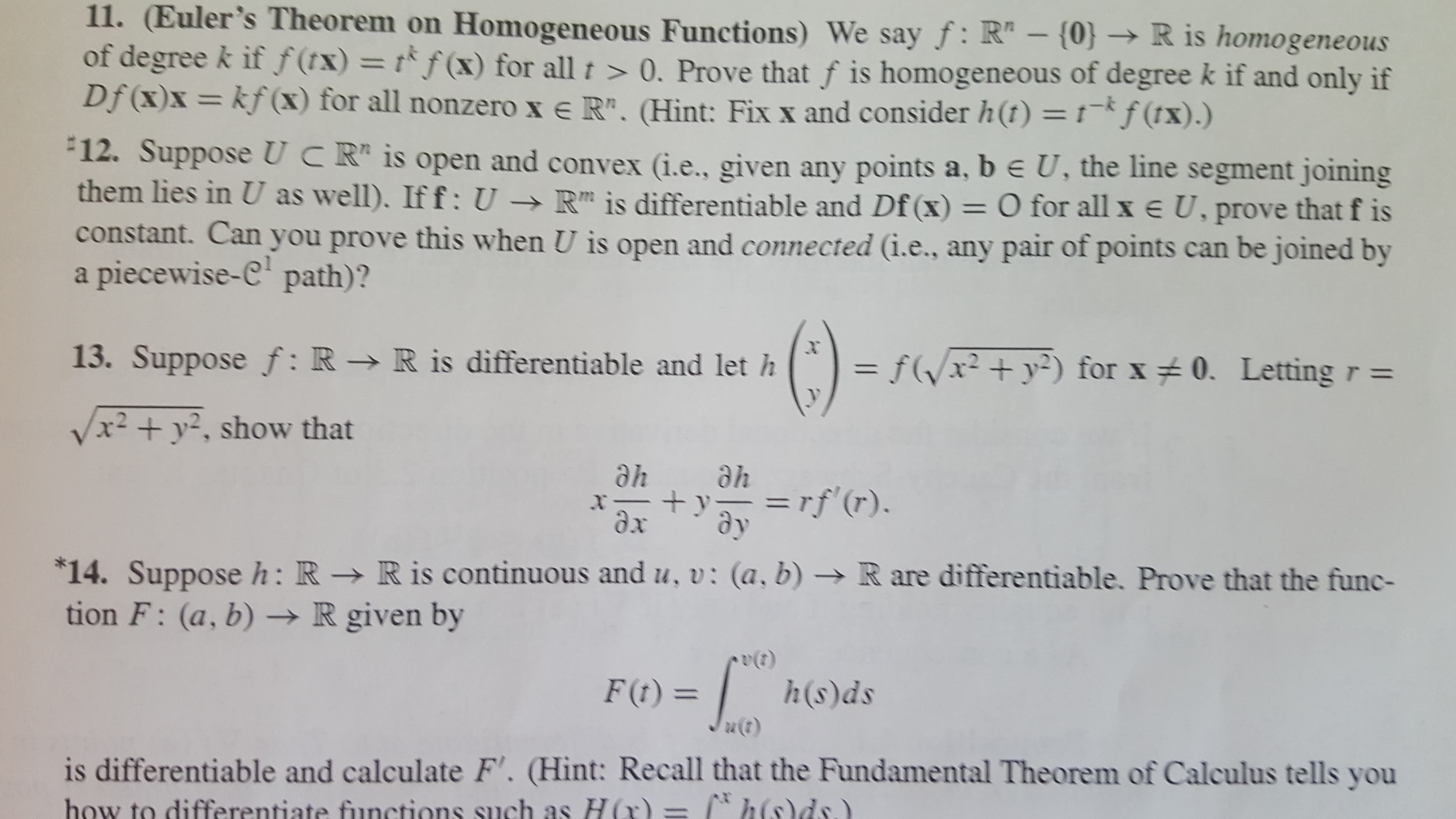11. (Euler's Theorem on Homogeneous Functions) We say f: R"- {0} R is homogeneous of degree k if f(tx) = tf(x) for all t >0. Prove that f is homogeneous of degree k if and only if Df (x)x= kf(x) for all nonzero x e R". (Hint: Fix x and consider h(t) = 1-*f (tx) .) 12. Suppose UCR is open and convex (i.e., given any points a, b e U, the line segment joining them lies in U as well). If f: U -R is differentiable and Df (x) = O for all x e U, prove that f is constant. Can you prove this when U is open and connected (i.e., any pair of points can be joined by piecewise-C path)? a 13. Suppose f: R > R is differentiable and let h fxy2) for x 0. Letting r = /x2 +y2, show that ahe he =rf(r). x dx 14. Suppose h: R - R is continuous and u, v: (a, b) tion F: (a, b) -R given by R are differentiable. Prove that the func- h(s)ds F(t)= is differentiable and calculate F'. (Hint: Recall that the Fundamental Theorem of Calculus tells you how to differentiate functions such as H (r) = 2
11. (Euler's Theorem on Homogeneous Functions) We say f: R"- {0} R is homogeneous of degree k if f(tx) = tf(x) for all t >0. Prove that f is homogeneous of degree k if and only if Df (x)x= kf(x) for all nonzero x e R". (Hint: Fix x and consider h(t) = 1-*f (tx) .) 12. Suppose UCR is open and convex (i.e., given any points a, b e U, the line segment joining them lies in U as well). If f: U -R is differentiable and Df (x) = O for all x e U, prove that f is constant. Can you prove this when U is open and connected (i.e., any pair of points can be joined by piecewise-C path)? a 13. Suppose f: R > R is differentiable and let h fxy2) for x 0. Letting r = /x2 +y2, show that ahe he =rf(r). x dx 14. Suppose h: R - R is continuous and u, v: (a, b) tion F: (a, b) -R given by R are differentiable. Prove that the func- h(s)ds F(t)= is differentiable and calculate F'. (Hint: Recall that the Fundamental Theorem of Calculus tells you how to differentiate functions such as H (r) = 2
Linear Algebra: A Modern Introduction
4th Edition
ISBN:9781285463247
Author:David Poole
Publisher:David Poole
Chapter4: Eigenvalues And Eigenvectors
Section4.6: Applications And The Perron-frobenius Theorem
Problem 70EQ
Related questions
Question
100%
Hello,
Please help me solve number 13 in the attachment.
Thank you very much.

Transcribed Image Text:11. (Euler's Theorem on Homogeneous Functions) We say f: R"- {0} R is homogeneous
of degree k if f(tx) = tf(x) for all t >0. Prove that f is homogeneous of degree k if and only if
Df (x)x= kf(x) for all nonzero x e R". (Hint: Fix x and consider h(t) = 1-*f (tx) .)
12. Suppose UCR is open and convex (i.e., given any points a, b e U, the line segment joining
them lies in U as well). If f: U -R is differentiable and Df (x) = O for all x e U, prove that f is
constant. Can you prove this when U is open and connected (i.e., any pair of points can be joined by
piecewise-C path)?
a
13. Suppose f: R > R is differentiable and let h
fxy2) for x 0. Letting r =
/x2 +y2, show that
ahe
he
=rf(r).
x
dx
14. Suppose h: R - R is continuous and u, v: (a, b)
tion F: (a, b) -R given by
R are differentiable. Prove that the func-
h(s)ds
F(t)=
is differentiable and calculate F'. (Hint: Recall that the Fundamental Theorem of Calculus tells you
how to differentiate functions such as H (r) =
2
Expert Solution
This question has been solved!
Explore an expertly crafted, step-by-step solution for a thorough understanding of key concepts.
This is a popular solution!
Trending now
This is a popular solution!
Step by step
Solved in 5 steps with 5 images

Knowledge Booster
Learn more about
Need a deep-dive on the concept behind this application? Look no further. Learn more about this topic, advanced-math and related others by exploring similar questions and additional content below.Recommended textbooks for you

Linear Algebra: A Modern Introduction
Algebra
ISBN:
9781285463247
Author:
David Poole
Publisher:
Cengage Learning

Linear Algebra: A Modern Introduction
Algebra
ISBN:
9781285463247
Author:
David Poole
Publisher:
Cengage Learning